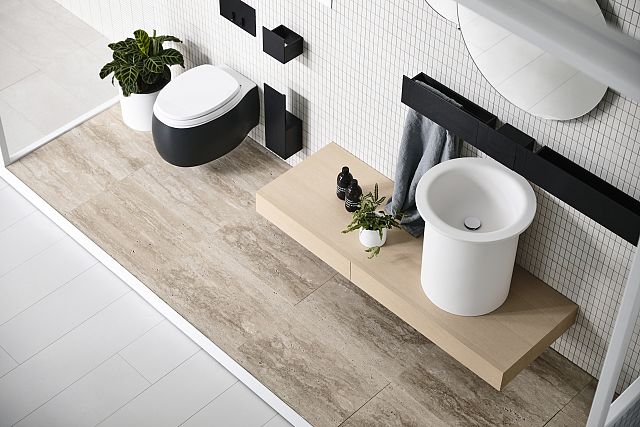As experts in stone, Artedomus has developed a catalogue of natural stone products based on durability and aesthetics. Whether its marble, quartzite or travertine, choosing the right product for your application is crucial to design and performance.
In our Expert Series on natural stone, you’ll learn about durability, patina and types of stone, and some of the essential information to consider in your decision.

What makes a stone durable?
Three elements make a stone more or less durable: hardness, porosity and chemistry. Hardness is a stone’s resistance to abrasion and corrosion. Quartzites and granites, for example, are incredibly hard. Porosity is a stone’s resistance to liquids, oils and abrasions, which sealants can provide extra resistance to if needed. And chemistry is how a stone will react to other elements. For example, acids can react with calcium carbonate to burn the stone, affecting its finish.
What is patina?
Patina is how a stone has changed and aged over time. Stone will typically look new and fresh when it’s installed, but can change with use and time. As it develops a patina it reflects your life, which becomes a beautiful part of stone that’s not present in virtually any other hard-surface material.
What are the different types of stone?
There are three types of stone: sedimentary, metamorphic and igneous.
Sedimentary stone forms from sediment – the end product of eroded or corroded stone. As sediment particles travel through water, they get heavily compacted by the weight of the water and can move deeper into the Earth’s crust to have even more pressure applied. You can even find shells and ancient fossils compressed within these sediment stones. Sedimentary stone is used for a variety of spaces and purposes, including floors, walls and cladding.
Metamorphic stone has changed state through heat and pressure. For example, limestone or sandstone that has gone back into the Earth’s crust where it is reheated and cracked under additional pressure. Metamorphic stone often has brilliant colours, tones and textures. Quartzites are one of the hardest and most durable stones on the market, making them suitable for bar tops, which are exposed to acid on a regular basis. It takes about three days to carve a 25-ton block of quartzite into 20-millimeter-thick slabs. Whereas it takes about one day to carve granite.
Igneous stone comes from deep in the Earth’s crust or from magma or lava. Granites, basaltinas and basalts are three types of igneous stone. They are very tough and durable, and typically have quieter or larger grain sizes, and less life that has touched the stone.
What is travertine?
Travertine is a hard, dense limestone-like product that is actually defined as a coral. It’s an incredibly durable material, although it has holes in it. You can retain the holes as part of the decorative element and beauty of travertine or fill them if you’re using it for a benchtop, vanity or floor. We work with Italy’s premier travertine producers to provide the strongest, densest and hardest travertine products on the market.
Is porcelain a suitable alternative?
Porcelain is a suitable alternative to natural stone when issues such as acid-etching or staining are a concern. As porcelain has no porosity, it is an incredibly durable material for a kitchen benchtop.
Porcelain can offer the look of marble, or a sleek, elegant and simple finish as is commonly being used today. Pair this with a vivid natural stone around the benchtop and it’s a beautiful combination.
Does the type of stone affect its use?
It’s important to ascertain what you want from your natural stone, rather than having preconceived notions about weaker or stronger materials based on how they are classified. We have some very hard limestones at Artedomus, and some very soft granites.
Instead, we recommend understanding the limitations of the material. Marbles are more prone to acid-etching and staining than quartzite, but if you prefer the look of marble, then it’s a case of learning how to look after the product so it maintains its performance and aesthetics.
Why is sourcing stone separate from its production?
As Artedomus’ heritage is Italian, we source a vast majority of our natural stone slabs from Italy because of their superior quarrying and production facilities. However, there are approximately 13,000 different quarried, natural stone products, and we have access to virtually all of them through our global network of agents and partners. No matter where the stone is quarried, we still have them sent to a factory in Italy where the stone is finished in a way that is better for us as the buyer and you as the end user.
View the rest of the Expert Series here